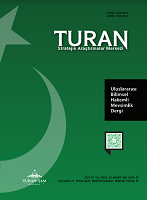YUNUS EMRE’NİN DİLİNDE CÜMLE YAPILARI
SENTENCE STRUCTURES IN YUNUS EMRE'S LANGUAGE
Author(s): Turan HÜSEYNOVASubject(s): Turkish Literature, Theory of Literature, Sociology of Art, History of Art, Stylistics, Sociology of Literature
Published by: Sage Yayınları
Keywords: Turkish languages; simple sentence; compound sentence; Yunus Emre; Divan;
Summary/Abstract: Our research shows that in the early stages of language development, simple sentences had a wider use. This does not mean the absence of compound sentences, only simple sentences are more in proportion when we compare them. As we know, it is not possible to have the sentence structures used historically in a language in the same way in modern period. Because the thoughts of people that have developed over the centuries have certainly reflected this to the language. A person who started to think differently more complexly began to express their ideas not with simple sentences, but with compound sentences. In 12-13th centuries poets and writers, who took refuge in the palaces at a time when the Byzantine power in the land was weakened and the Seljuks were getting stronger, began to create new style works. The language of the works of Yunus Emre, who lived and created in the 13th century, has a very important place in this regard. When we compare it with the sentence structures in the language of the monuments belonging the 7th century, we now see different compound sentence structures in Yunus Emre's language. In this article, sentences found in Yunus Emre's language were first diversified by meaning and later by structure.
Journal: TURAN-SAM
- Issue Year: 15/2023
- Issue No: 57
- Page Range: 36-43
- Page Count: 8
- Language: Turkish

